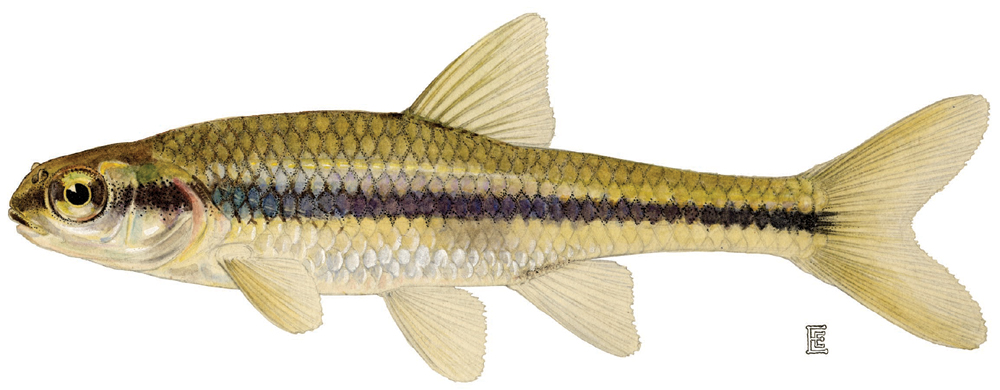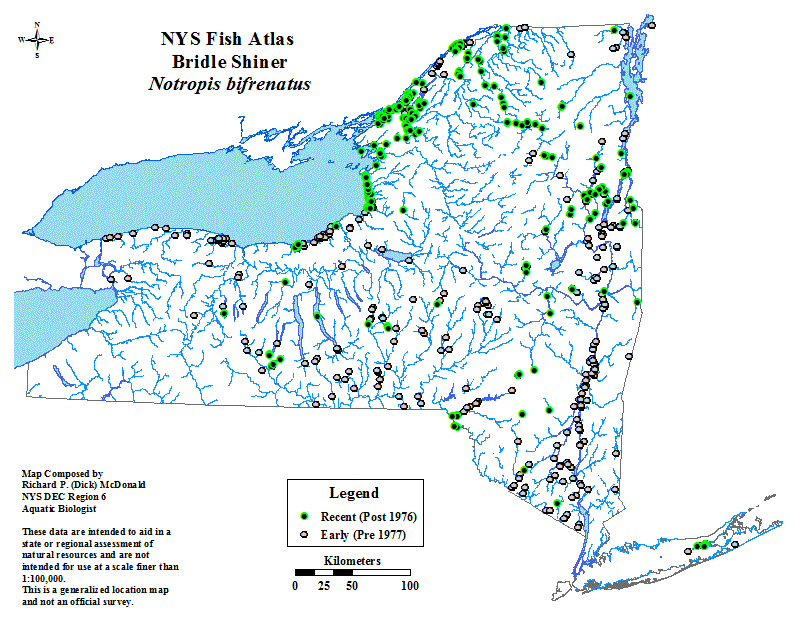
Bridle Shiner (Notropis bifrenatus)
This is an Atlantic coast species ranging from eastern New Hampshire to the Rappahannock, York, James and Chowan drainages of Virginia and the Neuse River of eastern North Carolina. In New York, it occurs throughout the eastern part of the state and west along the south shore of Lake Ontario to west of Rochester. It occurs in the Peconic and other streams of eastern Long Island. It does not occur in or west of the Genesee.
The bridle shiner is a widespread species that lives in warm, still, or slow-moving waters of small streams and ponds and the slow parts of larger lakes and rivers. It is usually found over mud, silt, or debris and prefers areas of moderate amounts of vegetation. It is sometimes found in slightly brackish water in the southern part of its range.
Spawning takes place between 22 May and 31 July. (2 May to August at Ithaca, June and July in Connecticut). The spawning sites are located in water about 2 feet deep in openings surrounded by dense emergent vegetation, where there is no perceptible current. Spawning activity usually begins before daylight and is most vigorous between 7 am and 2 pm. Females are pursued by males, which are usually smaller. Before spawning, the females hover nearly motionless close to the surface. The males bump their snouts along the females' lower sides and snouts. If the female is not ready to spawn, she moves away and resumes feeding. A few days later, there are chases which appear to be the spawning act. Usually, one male starts to chase the female and one or two other males join the chase. Sometimes, a male discontinues the pursuit to chase another male and sometimes a male switches to another female. Normally, the pursuits lasts from 1 second to about 1 minute during which they cover a distance of several meters. As the chase proceeded, the males bump the females with their snouts. The chase appears to end in a slight curve with the female flanked by two or sometimes only one male. At times, several pursuits are going on at once in a small area with complex interactions. Although other species such as small chubsuckers and golden shiners are chased from time to time, no regular territories are held. Spawning apparently occurres many times during the day and only a few eggs are released each time. The eggs sink to the bottom and adhere to the vegetation. Water-hardened eggs are approximately 1.5 mm in diameter and hatch in 57 hours at 75 F. The newly hatched young, about 5 mm long, remain in the vegetation at first, then begin to swim in small groups. By late July, they are in schools of 100 or more and by August when they are about 22 mm standard length, they join schools of adult fish.
Feeding is by sight and occurs only during daylight hours. Most of the feeding is observed where the water is still or there is a slight current. Food is taken from plant surfaces and the bottom; plankton organisms are taken on or near vegetation. Small insects are the most important items, constituting 36 percent of the volume and in 73 percent of the stomachs. Crustaceans make up another 24 percent of the volume. Amphipods, water mites, mollusks, and plant materials are also taken in significant quanitities.
Distribution of bridle shiners in NY state.
A 130 KB image of the bridle shiner is also available for download.
The above species description was taken out of "The Inland Fishes of New York State" by C. Lavett Smith, published by the New York State Department of Environmental Conservation, 1985.
